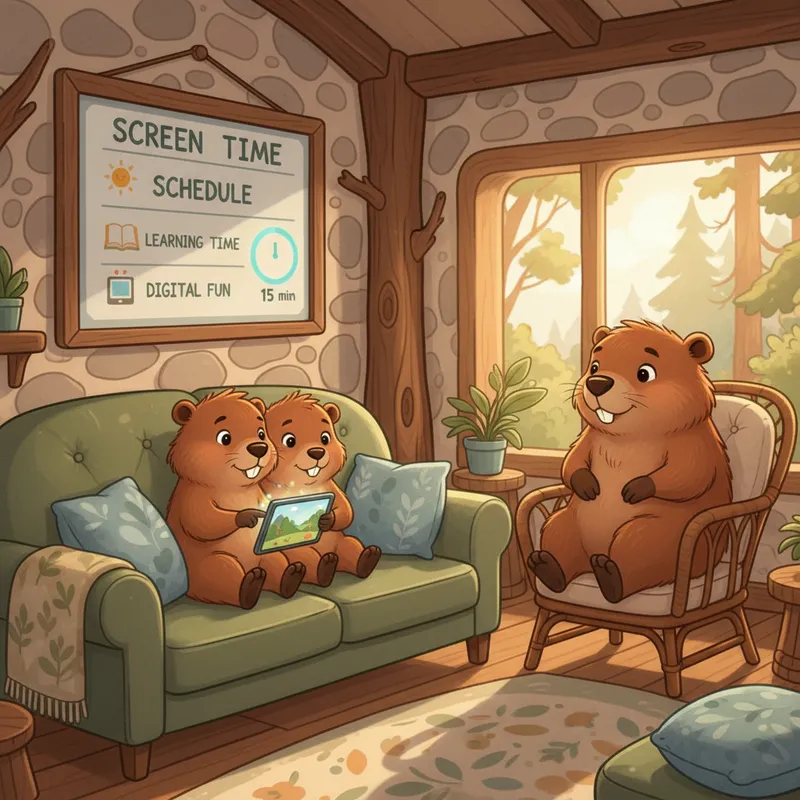How We Got Our Kids to Stop Fighting Over Screen Time
“Can I have screen time?” “It’s my turn on the iPad!” “You’ve been on for TWO HOURS!” “NO I HAVEN’T!” “MOM! HE WON’T GET OFF!”
Sound familiar? Screen time is the #1 battle in modern families. You’re not alone, and you’re not failing.
Here’s how our family (and others) finally stopped fighting about screens—with systems that actually work. 💚
Why Screen Time Becomes a Battlefield
The Problem Isn’t Screens—It’s Uncertainty
Kids fight about screen time when:
- Rules aren’t clear or consistent (“Maybe Mom will say yes today?”)
- No visual system tracks time (debates about “how long you’ve been on”)
- Limits feel arbitrary (Why 30 min today, 60 yesterday?)
- Enforcement is inconsistent (Sometimes you follow through, sometimes not)
- Consequences aren’t automatic (requires your intervention every time)
The pattern:
Kid asks for screen time
→ You decide in the moment
→ Kid negotiates/argues
→ You give in or fight
→ Repeat 5x/day
→ Everyone exhaustedWhat Finally Worked: The 3-Part System
Part 1: Clear, Consistent Rules
The Foundation: Kids can handle rules they understand, see, and know won’t change based on your mood.
Our Family’s Screen Time Rules:
✅ Weekday Limits:
- School days: 30-60 min total
- Earned AFTER chores and homework
- Not before school (too hard to stop)
- No screens during meals or 1 hour before bed
✅ Weekend Limits:
- Saturday/Sunday: 90-120 min total
- Can be split (60 min morning, 60 min afternoon)
- Still earned after morning chores
✅ What Counts as Screen Time:
- Tablets, phones, video games, TV
- YouTube, social media, gaming
- Does NOT count: School work, educational apps (with verification), family movie night together
Why it works:
- Consistent (same rules every weekday)
- Clear (kids know exactly what to expect)
- Fair (everyone has same limits)
- Visual (posted where everyone sees)
Part 2: Visual Tracking System
The Game-Changer: Instead of arguing about “how long you’ve been on,” use a system everyone can SEE.
Option A: FamilyCast Screen Time Tracker (Our choice):
- Display in kitchen shows each kid’s screen time balance
- Counts down in real time
- Kids can check anytime (“How much time do I have left?”)
- Automatic—no debate
Option B: Kitchen Timer + Whiteboard:
- Each kid gets a section on whiteboard
- Write their daily allowance (60 min)
- Set kitchen timer when they start
- Erase minutes as they’re used
- When it hits zero, time’s up
Option C: Apps with Parent Controls:
- Screen Time (iPhone/iPad)
- Family Link (Android)
- Circle Home Plus (works with WiFi router)
- Bark, Qustodio, Net Nanny
Why visual tracking works:
- Eliminates “You’ve been on for hours!” “No I haven’t!” debates
- Kids can see their balance (reduces asking “Can I have more?”)
- Automatic enforcement (system handles it, not you)
- Teaches time management
Part 3: Earn, Don’t Beg
The Shift: Screen time isn’t a gift you grant or withhold based on mood. It’s earned through completing responsibilities.
How It Works:
Daily Requirements (before screen time unlocks):
- Chores completed
- Homework done
- Reading time (15-20 min)
- Outdoor play / physical activity (20-30 min)
Visual System:
- FamilyCast displays checklist
- Kids check off tasks as completed
- Screen time “unlocks” when checklist is done
- No nagging from you—system handles it
Example:
Tommy's Checklist (Wednesday):
✅ Make bed
✅ Put dishes in sink
✅ Homework (math + spelling)
✅ Read for 20 minutes
⬜ Screen time unlocked! 60 min available.Why it works:
- Natural consequence (want screens? Do your tasks)
- No negotiation (system is the enforcer, not you)
- Builds responsibility (they control the outcome)
- Reduces your mental load (not tracking who’s done what)
Age-Specific Screen Time Guidelines
Ages 2-5: Minimal and Supervised
Recommended Limit: 30 min/day max
Why:
- Brain development needs active play, not passive screens
- Can’t self-regulate yet
- High risk of tantrums when screen time ends
What Works:
- Screen time = special treat (not daily default)
- Always supervised (you watch with them)
- Educational content only (PBS Kids, educational YouTube)
- Timer visible (they can see countdown)
- Transition warning: “5 more minutes, then all done”
Ages 6-9: Building Self-Regulation
Recommended Limit: 60 min/day on school days, 90-120 min weekends
Why:
- Learning self-control with guidance
- Screen time becomes social (Roblox, Minecraft with friends)
- Homework and activities take more time
What Works:
- Earn system (screen time after responsibilities)
- Timer they can check themselves
- Mix of entertainment and educational
- No screens before school (too disruptive)
- 1 hour before bed = screen-free
Ages 10-13: Negotiated Independence
Recommended Limit: 90 min/day on school days, flexible weekends
Why:
- Social life increasingly online (texting, gaming with friends)
- Homework may require devices
- Developing ability to self-manage
What Works:
- Weekly total (let them allocate: “You have 10 hours this week, manage it”)
- Differentiate social time vs. mindless scrolling
- Non-negotiables: No phones at dinner, in bed, during family time
- Teach digital citizenship (what they post, who they talk to)
Ages 14+: Self-Management with Guardrails
Recommended Limit: Focus on behavior, not time
Why:
- Screens are necessary (school, social, work)
- Time limits feel infantilizing (builds resentment)
- Need to learn self-regulation before adulthood
What Works:
- Outcome-based: “If grades drop or you’re not sleeping, we revisit”
- Non-screen zones: Dinner table, overnight (phone charges outside bedroom)
- Open conversations: “Are you happy with how much you’re on your phone?”
- Teach balance: “Make sure you’re seeing friends IRL, not just online”
Common Screen Time Battles (And How to Win)
Battle #1: “Just 5 More Minutes!”
Why it happens: Screens are designed to be addictive. Stopping is genuinely hard.
The Fix: ✅ Transition warnings: “10 min left” → “5 min left” → “1 min left” ✅ Visual timer: They can SEE time running out ✅ Natural ending points: “When this episode ends” (not mid-show) ✅ No negotiation: Time’s up = device gets put away (by them or you)
Script: “I understand you want more time. Our family rule is 60 minutes. Your time is up. You can try again tomorrow.”
Battle #2: “Everyone Else Gets More Time!”
Why it happens: Kids compare, and yes, some families have unlimited screens.
The Fix: ✅ Acknowledge feelings: “I know it feels unfair when friends have different rules” ✅ Hold your boundary: “This is OUR family’s rule. We made it because [brain health / family time / whatever your reason]” ✅ Don’t defend excessively: You don’t owe a 47-point argument. “This is our decision” is enough.
Script: “I hear you. Our family does things differently. Our rule stands.”
Battle #3: Siblings Fighting Over Devices
Why it happens: Multiple kids, not enough devices
The Fix: ✅ Scheduled turns (posted visibly):
- Mon/Wed/Fri: Kid A gets first turn (4-5pm)
- Tue/Thu/Sat: Kid B gets first turn (4-5pm)
- Sunday: Shared or negotiated
✅ Separate devices when possible: Even cheap tablets ($50-100) reduce fights
✅ Family device rule: “This iPad belongs to the family. You get scheduled time. If you fight, both lose access today.”
Battle #4: Sneaking Devices After Bedtime
Why it happens: Phones/tablets in bedrooms = temptation
The Fix: ✅ Charging station outside bedrooms: All devices charge in kitchen/living room overnight ✅ Bedtime = turn-in time: No exceptions (yes, even on weekends) ✅ Enforce consistently: If caught with device after bedtime, lose next day’s screen time
Why it matters: Blue light disrupts sleep. Teens especially need sleep. Non-negotiable.
What Happens When Rules Are Broken
Natural Consequences (Automatic)
If time limit exceeded:
- Next day’s screen time reduced by overage amount
- Example: Used 80 min instead of 60? Tomorrow you get 40 min.
If devices used during banned times (meals, bedtime, before chores):
- Device lost for 24 hours
- No negotiation, no exceptions
If fighting/arguing about screens:
- Both kids lose access for rest of day
- Teaches problem-solving instead of fighting
The Screen-Free Alternatives (That Actually Work)
The Problem with “Go Play Outside”
Telling kids “stop staring at screens and go do something” doesn’t work without OPTIONS.
What Works Instead
✅ Screen-Free Activity Menu (posted in kitchen):
- Board games shelf (labeled and accessible)
- Art supplies bin (coloring, crafts, Play-Doh)
- Building toys (Legos, blocks, Magna-Tiles)
- Books basket (rotated monthly from library)
- Outdoor toys (bikes, chalk, jump rope)
- “Boredom jar” (activity ideas on popsicle sticks)
✅ Scheduled screen-free time:
- Family game night (Fridays 7-8pm)
- Sunday hike/park/adventure
- Meal times (everyone, including parents)
- Morning routine (no screens before school)
✅ Parent modeling:
- Put YOUR phone away during family time
- Read books where kids see you
- Play outside with them
- Show that screens aren’t the default
Truth: Kids complain about being bored for 15 minutes, then they engage. Don’t rescue them from boredom—it’s where creativity lives.
How FamilyCast Makes Screen Time Easier
What Families Love:
- Visual screen time tracker (kids see their balance in real-time)
- Automatic countdown (no more “How long have I been on?” debates)
- Linked to chores (screen time “unlocks” when tasks are complete)
- No nagging needed (system handles enforcement)
- Customizable per kid (different limits for different ages)
How it works:
- Set each kid’s daily screen time limit
- Link to completed tasks (chores, homework, reading)
- Display shows real-time countdown
- When time’s up, screen time is over—system handles it, not you
Parent benefits:
- Less arguing (visual system = no debate)
- Less mental load (you’re not tracking everyone’s time)
- Consistency (same rules every day, automatic)
- Peace (kids know what to expect, reduces conflict)
Try FamilyCast Free for 14 Days →
Remember This 💚
- Screen time battles stem from unclear rules and inconsistent enforcement
- Visual systems work better than memory and negotiation
- Earn, don’t beg (screen time unlocks after responsibilities)
- Age-appropriate limits (5-year-olds and 15-year-olds need different rules)
- Natural consequences teach better than lectures
- Model the behavior you want (put your phone away too!)
- Screen-free alternatives need to be as easy as grabbing a tablet
The Bottom Line: You can’t eliminate screens from modern childhood. But you CAN set healthy boundaries without daily fights.
Your Turn!
What’s YOUR biggest screen time struggle? What rules work for your family? Drop a comment and let’s help each other! 💬
Ready to end the screen time battles? Try FamilyCast free—set up screen time tracking and chore linkage in 10 minutes. Peace is possible! 💚
More Family Organization Resources
- 📖 Why Your Paper Chore Chart Isn’t Working
- 🎯 Age-by-Age Guide: Chores Your Kids Can Handle
- 💡 Free Printable Screen Time Tracker
Related Topics: screen time for kids, screen time limits, managing devices, parenting tips, reduce screen time, family rules, technology and kids

